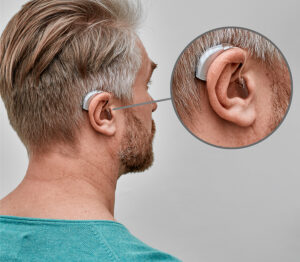A discussion of hearing loss is not possible without mentioning hearing aids. The ENT specialist is doing for the patient with hearing loss what is possible. But now the patient depends on a hearing aid to amplify the remaining hearing capacity. Alternatively, the patient must simply accept that a certain amount of hearing loss remains.
Every case is different and I can only give a brief overview here. However, the ENT specialist will also advise you whether a conventional hearing aid or a cochlear implant will help.
Switch from analog to digital technology
The technology has improved vastly in the 1990’s when there was a switch from analog to digital technology for conventional hearing aids. Parallel to digitalization downsizing of conventional hearing aids occurred. They are useful for 10 to 40 decibel hearing loss. On the other hand, cochlear implants are useful for deaf persons with 40 decibel hearing loss or worse.
There has been a silent revolution regarding hearing aids and cochlear implants in the 1990’s because of new technology. People who used to be deaf can now hear! Old age deafness can now mostly be remedied with conventional hearing aids and severe hearing loss can be solved with cochlear implants. Ask your physician and get a referral to an ENT specialist.
Conventional hearing aids
Most patients with mild to severe conductive hearing loss and many patients with sensorineural hearing loss will benefit fom one or two conventional hearing aids that can be molded into the ear canal.
Most patients with high frequency hearing loss and those with hearing loss only on one ear will benefit from the conventional hearing aid. Here is a link to a site that has a detailed description of this technology and pictures of some of the devices. It is important that both ears hear about equally well as this enables a person to have directional hearing. The human ear is very sensitive in discriminating millisecond time differences. Your subconscious processes this and tells the person from which direction the sound originated. This is taken into consideration when the hearing aid is fitted.
Cochlear Implants
This newer technology has revolutionized the treatment of deaf people, cochlear implants. A picture of a cochlear implant can be found under this link as well as a more detailed description.
Here I am merely mentioning that there is a microphone that is usually located behind the ear, from which sound is translated into electric current modulations. This is sent through two induction coils into an internal electrode that is connected to a branch of the 8th cranial nerve (the hearing nerve) and the brain can process this signal as a sound. By way of the outside induction coil and the inside induction coil it is possible to have the two parts of technical equipment separated so that infections of the implanted electrode will not occur.
Speech pathologist necessary to relearn language skills
The surgery for the cochlear implant is only one part of the overall process. The other part is the work with a knowledgeable speech pathologist to relearn language skills and sounds. Those who had good hearing in the past are able to utilize their past audiology knowledge and learn much faster than those who have been congenitally deaf. Cochlear implants are truly one of he greatest achievements of modern technology!
References
1. The Merck Manual, 7th edition, by M. H. Beers et al., Whitehouse Station, N.J., 1999. Chapter 84.
2. Noble: Textbook of Primary Care Medicine, 3rd ed.,2001, Mosby Inc.
3. The Merck Manual, 7th edition, by M. H. Beers et al., Whitehouse Station, N.J., 1999. Chapter 85.
4. Rakel: Conn’s Current Therapy 2001, 53rd ed.,2001, W. B. Saunders Company
5. Goldman: Cecil Textbook of Medicine, 21st ed.,2000, W. B. Saunders Company
6. Mandell: Principles and Practice of Infectious Diseases, 5th ed.,2000, Churchill Livingstone, Inc.
7. The Merck Manual, 7th edition, by M. H. Beers et al., Whitehouse Station, N.J., 1999. Chapter 265.
8. MF Williams: Otolaryngol Clin North Am; Oct1999; 32(5): 819-834.
9. The Merck Manual, 7th edition, by M. H. Beers et al., Whitehouse Station, N.J., 1999. Chapter 106.
10. Ferri: Ferri’s Clinical Advisor: Instant Diagnosis and Treatment, 2004 ed., Copyright © 2004 Mosby, Inc.
11. Rakel: Conn’s Current Therapy 2004, 56th ed., Copyright © 2004 Elsevier







